
Marrigje de Maar »
Red Roses, Yellow Rain
Exhibition: 5 Mar – 29 May 2011

Huis Marseille
Keizersgracht 401
1016 EK Amsterdam
+31 (0)20-5318989
info@huismarseille.nl
www.huismarseille.nl
Tue-Sun 11-18

Marrigje de Maar - Red Roses, Yellow Rain
Existential Theme
Marrigje de Maar photographs the ephemeral world of the home, of being rooted. As she sees it, the essence of this universal human value is mainly to be found inside a house. Within its walls this could be anything from the space around the hearth, a living room, a kitchen or the area where people sleep. De Maar seeks those striking and magical places where families have come together for generations—where life has 'worn itself into' a house. Modernity, style and status, folklore and even interior design are all, in her view, subordinate to the revelation of this subtle weave that life and cohabitation have imposed on these houses through the course of time.
Sphere of Activity
Remarkably, though, the territory that she has chosen for this investigation—China—is far removed from her own Dutch culture. There she has photographed the interiors of hundreds of houses. Now, after six years and five trips to China, Red Roses, Yellow Rain represents a substantial group of work that has great social/historical as well as artistic value. Though it may simply be a matter of chance, the timing of this project did coincide with an unprecedented surge of new building by which China aimed, in a single stroke, to present itself as a modern nation. While vast areas of housing in many Chinese communes were being demolished in order to make way for the modern age and its contemporary lifestyle and attitudes, De Maar found a surprising diversity of types and uses of classical living spaces. There are stone and wooden houses, as well as the Mongolians' felt steppe tents, called tepees or yurts. We also see a few examples of the most frugal dwellings, such as mud huts and the minimalist urban-workers’ quarters consisting of a bed, a clothesline and a chair. Never before has the worn and intimate character of household life in China, in all its culturally hybrid forms, been revealed in such a direct manner.
Contrast or Culture Clash?
Regarded in this context, the photographs of Marrigje de Maar constitute a modest but very distinct contrast. The lived-in antiquity that she shows us is, to our Western eyes, far more fascinating than the posters of sterile paradises heralding new development in China. Her defense of existential household values is certainly no obstruction to progress and the accompanying status of luxury. About this she is very explicit. Her work does give rise to questions. Just how important is a culture's link with the past? And why, in fact, are Westerners so fond of looking at other people's interiors? In Europe heritage, culture and history have become an integral part of our daily life. In southeastern Asia the prevailing point of view is that culture, often construed as craftsmanship, can be replaced and copied. From this East/West culture clash, the inspired yet highly critical American Japanologist Alex Kerr saw the rise of a hideous 'Frankenstein' monster. Why, when Asians modernize, can they not preserve that which has value? Kerr mentions several causes. Partly due to its much more open language, he says, the West displays "fewer discrepancies between modern and ancient culture." More importantly, there needs to be time for this. "In contrast to Europe, however, change came to China, Japan and Southeast Asia in a truly precipitous fashion. What is more, these changes were introduced from a completely alien culture." Will the tourist who visits China in the future have to make due with theme parks in a pseudo-traditional style? 'No' is Kerr's quoted response of a Japanese Kabuki actor: "Kyoto is beyond preservation. The next step will be re-creation." 'No' is Marrigje de Maar's response as well. China has gone through so many drastic periods that, partly in view of the country's sheer size, there will always be plenty left over.
Interior Photography
Not many, but certainly some very distinct interior photographers have shown work at Huis Marseille over the years. Candid Höfer and Jacqueline Hassink, for instance. Like Marrigje de Maar, they made the interior their 'core business'. Because the presence of people in photographed interiors draws too much attention from the viewer, De Maar considers the interior itself a portrait of an identity. This stands in contrast to the photographs of Bert Teunissen, Eskö Mannikö and Dayanita Singh, who emphatically situate their portraits of people in an interior. From a photographic point of view, Marrigje de Maar's works are little masterpieces, in terms of their chiaroscuro—having been taken with only the scarce sunlight cast in—but also in terms of their spatial quality. Any use of flash or electrical lighting would have affected both the color intensity and the spatial quality. It is particularly this critical balance of light and shadow which makes her work so extraordinary and which moreover places her work in a characteristically Dutch artistic tradition.
Biography
Marrigje de Maar (1944, The Hague) was trained as a sociologist, and later as a photographer as well. In 2004 she received the Lucie Award in New York and, in that same year, was among the winners of the Zilveren Camera. Her work has been exhibited at the Nederlands Fotomuseum Rotterdam, Foam Amsterdam and at the Finnish Museum of Photography in Helsinki. She has participated in group exhibitions at the Victoria & Albert Museum, London, and the Bonnefantenmuseum in Maastricht. Her work is represented in various collections within the Netherlands and abroad. For further information, see: www.takeadreamforawalk.com
Publication
Marrigje de Maar / Red Roses, Yellow Rain, including texts by Els Barents and Marrigje de Maar; publisher Hatje Cantz 2011; ISBN 978-3-7757-3001-3.

